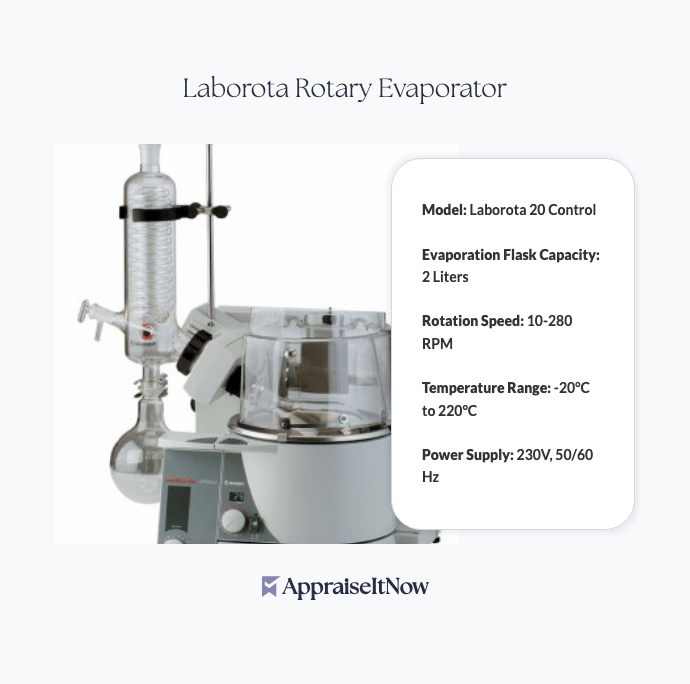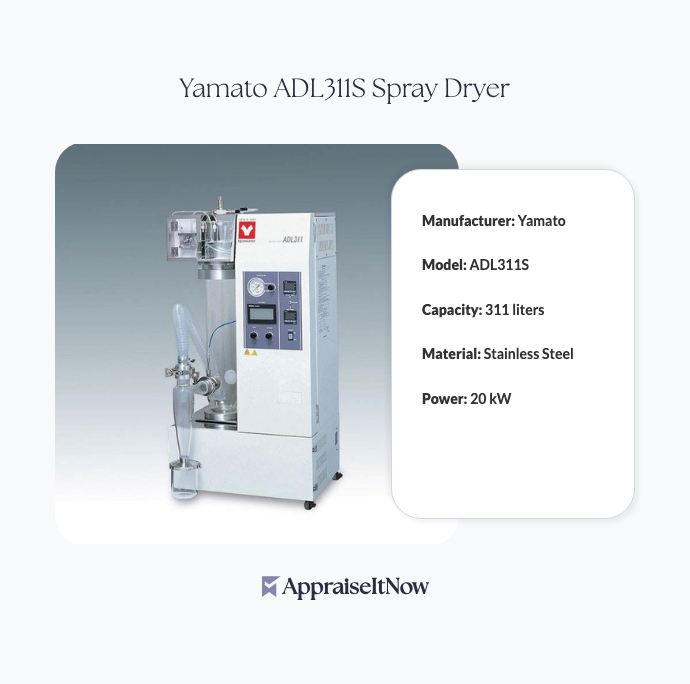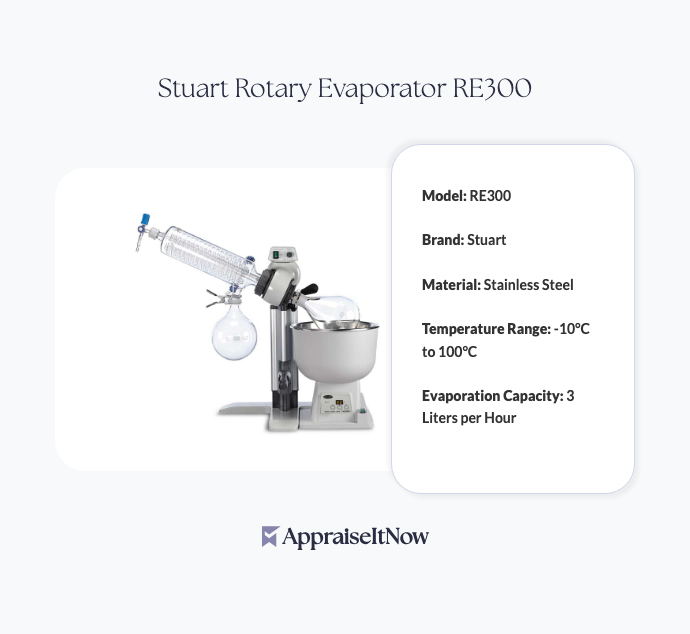<h1>How to Get Your Laborota Rotary Evaporator Appraised</h1>
<p>The Laborota Rotary Evaporator is a sophisticated piece of laboratory equipment used extensively in organic chemistry, pharmaceuticals, and natural product extraction. Whether you're planning to sell, insure, or donate your unit, obtaining an accurate appraisal ensures you understand its true market value. Current fair market estimates for this specialized equipment range from <strong>$35,000 to $40,000</strong>, though your specific unit's value depends on multiple factors that professional appraisers evaluate systematically.</p>
<h2>Understanding the Laborota Rotary Evaporator's Market Position</h2>
<p>Since its introduction in 1990, the Laborota has earned recognition among leading research institutions for its precision temperature control, efficient vapor condensation system, and user-friendly design. The equipment features patented vapor cooling technology and stainless steel construction—elements that directly contribute to its strong resale value when the unit is maintained properly.</p>
<p>The demand for quality <a href="/types/lab-equipment">laboratory equipment</a> remains robust within research facilities and specialized industrial settings. Understanding your evaporator's specifications helps you appreciate why professional appraisals matter. Your Laborota's value reflects both its technical capabilities and its application potential in professional research environments.</p>
<h2>Key Factors That Influence Your Laborota's Appraisal Value</h2>
<p>Several distinct elements shape how appraisers determine your rotary evaporator's worth. The model designation, production year, and current operational condition form the foundation of valuation. Beyond these basics, the presence of calibration records, service history, and included accessories significantly impact the final appraised amount.</p>
<p><strong>Production year and model type</strong> matter considerably. Newer units or those produced during peak manufacturing efficiency typically command higher valuations. A Laborota manufactured in recent years with minimal use presents differently from an older model with extensive laboratory service, even if both function perfectly.</p>
<p><strong>Operational condition</strong> represents perhaps the most crucial factor. Does your evaporator maintain proper temperature control? Are all digital displays functioning? Do safety features operate reliably? Appraisers conduct detailed inspections examining the motor-driven rotary flask, condensation efficiency, and heating element responsiveness. Units showing wear patterns, potential repairs, or recalibration needs will reflect lower valuations than pristine examples.</p>
<p><strong>Calibration certificates and service documentation</strong> become essential for establishing legitimacy. If your Laborota has been professionally serviced and calibrated within the past year or two, this documentation supports higher valuations. Research facilities trust equipment with verifiable maintenance records, making these papers valuable during appraisal processes.</p>
<h2>Documentation and Photographs Appraisers Need</h2>
<p>When preparing your Laborota for appraisal, gathering proper documentation streamlines the process and supports accurate valuation. Professional appraisers specializing in <a href="/types/chemical-equipment">chemical equipment</a> require specific information to produce USPAP-compliant reports.</p>
<p>Your unit's <strong>serial number</strong> appears on a plate typically located on the base or main housing. This identifier helps appraisers cross-reference production records and verify authenticity. Photograph this clearly from multiple angles, as it often features additional production date information.</p>
<p><strong>Service history documentation</strong> proves invaluable. Collect any invoices from maintenance visits, calibration certificates from authorized service centers, and records of component replacements. These documents demonstrate that your evaporator has received professional care, directly supporting fair market value assessment. If you lack formal documentation, photographs showing the equipment's condition from multiple angles—including close-ups of wear patterns, display screens, and heating elements—help appraisers make informed condition evaluations.</p>
<p>Include photos of the complete unit from at least four angles, detailed shots of the control panel and display, images of any included accessories or spare parts, and documentation of the power specifications and technical data plate. This comprehensive photographic record allows appraisers to conduct detailed evaluations without necessarily requiring on-site inspection in many cases.</p>
<div class="callout tip"><p><strong>Documentation Strategy</strong></p>
<p>Create a folder containing your Laborota's serial number, purchase documentation, all service invoices, calibration certificates, and technical specifications before contacting an appraiser.</p></div>
<h2>Photo-Based Versus On-Site Appraisals for Laboratory Equipment</h2>
<p>Many owners wonder whether online photo-based appraisals provide reliable valuations for specialized equipment like rotary evaporators. The answer depends on your specific circumstances and the unit's condition.</p>
<p><strong>Photo-based appraisals work well when</strong> your Laborota appears to be in good operational condition with clear documentation, the equipment shows no obvious damage or unusual wear, and you have calibration or service records demonstrating proper maintenance. Experienced appraisers with <a href="/types/lab-equipment">laboratory equipment</a> expertise can often provide accurate estimates using high-quality photographs, detailed descriptions, and documented specifications. This approach offers convenience and often faster results at lower costs.</p>
<p><strong>On-site inspections become necessary when</strong> your evaporator shows visible damage or significant wear, you lack documentation and need in-person evaluation of operational status, the unit has been idle for extended periods and requires functional verification, or you're appraising a significant collection of <a href="/types/equipment-and-machinery">equipment and machinery</a> where comprehensive assessment benefits your insurance or business valuation needs.</p>
<p>AppraiseItNow's tech-enabled platform streamlines the process by allowing you to submit photographs, descriptions, and documentation securely online. Our credentialed experts across the U.S.—holding certifications from organizations including AAA, ISA, ASA, CAGA, and AMEA—evaluate your materials and provide certified appraisals that meet professional standards. For most Laborota units in decent condition with accessible documentation, this approach delivers both accuracy and efficiency.</p>
<div class="callout note"><p><strong>Expert Insight</strong></p>
<p>Credentialed appraisers specializing in laboratory and chemical equipment understand nuances that general appraisers miss, ensuring valuations reflect true market conditions for research institutions.</p></div>
<h2>Fair Market Value Versus Replacement Cost and Liquidation Value</h2>
<p>Understanding different valuation approaches prevents confusion during the appraisal process. Fair market value—the price at which your Laborota would sell between a willing buyer and willing seller under normal market conditions—typically ranges from $35,000 to $40,000 for quality examples. This represents what an active research facility or equipment dealer would reasonably pay.</p>
<p><strong>Replacement cost</strong>, by contrast, refers to acquiring a brand-new unit with equivalent specifications and capabilities. New Laborota evaporators often command $45,000 to $55,000 or higher, reflecting manufacturing, distribution, and dealer markup. This valuation becomes relevant primarily for insurance replacement coverage scenarios where you need to know what rebuilding your lab would cost.</p>
<p><strong>Liquidation value</strong> addresses what you'd receive in a forced-sale environment—perhaps during estate dispersal, laboratory closure, or auction scenarios. This typically represents 40-60% of fair market value, reflecting the pressure to sell quickly without time for optimal marketing. Understanding which valuation approach applies to your specific situation—whether you're selling privately, seeking insurance coverage, claiming tax deductions, or using equipment as loan collateral—helps ensure the appraiser provides the right type of valuation.</p>
<p>For most ownership situations, fair market value is what you need. Appraisers will clarify which standard applies to your specific purpose.</p>
<h2>Common Value Adjustments for Rotary Evaporators</h2>
<p>Several circumstances adjust your Laborota's base valuation up or down from the standard $35,000-$40,000 range. These adjustments reflect market realities and specific equipment conditions that experienced appraisers account for systematically.</p>
<p><strong>Positive adjustments</strong> include complete original accessories and spare parts still packaged with the unit, recently completed calibration certification from an authorized service center, documented use exclusively in controlled laboratory environments, matching original packaging or protective covers, and extended warranty documentation if still valid. Each of these factors can add 5-15% to your evaporator's value, reflecting reduced buyer risk and operational readiness.</p>
<p><strong>Negative adjustments</strong> reflect compromised value scenarios. Missing calibration records or inability to verify maintenance history typically reduces value by 10-20%. Signs of corrosion on stainless steel components or damage to the vapor cooling system subtract significant amounts. Repairs needed to restore full operational capability, missing original parts replaced with non-OEM alternatives, and evidence of heavy use in harsh chemical environments all warrant downward adjustments. A unit requiring recalibration before reliable use would see a 15-25% reduction reflecting the buyer's costs and risks.</p>
<p>Your appraiser will identify and quantify these adjustments, providing detailed explanations in your final report. This transparency ensures you understand exactly how your specific Laborota's characteristics influenced the valuation.</p>
<h2>Why Appraiser Credentials Matter for Specialized Equipment</h2>
<p>Selecting an appraiser with proper credentials protecting your interests deserves careful attention. Laboratory and <a href="/types/chemical-equipment">chemical equipment</a> appraisals require specialized knowledge beyond general equipment valuation expertise. </p>
<p>Seek appraisers holding certifications from recognized professional organizations. The <strong>American Society of Appraisers (ASA)</strong>, <strong>International Society of Appraisers (ISA)</strong>, <strong>American Association of Appraisers (AAA)</strong>, and similar bodies establish rigorous standards ensuring members understand USPAP (Uniform Standards of Professional Appraisal Practice) compliance. These credentials indicate your appraiser has demonstrated technical competency, continues professional education, and maintains ethical standards that protect clients.</p>
<p>For equipment like the Laborota, appraisers should demonstrate specific experience with laboratory and scientific instrumentation. Ask potential appraisers about their background evaluating rotary evaporators and similar equipment. How many Laborota appraisals have they completed? Can they provide references from research institutions or equipment dealers? Do they understand both fair market value and replacement cost approaches? These questions help you identify truly qualified professionals.</p>
<div class="callout note"><p><strong>Credential Check</strong></p>
<p>Credentialed appraisers like those available through AppraiseItNow carry professional liability insurance, maintain ethical standards, and produce reports meeting legal and financial institution requirements.</p></div>
<h2>Appraisal Uses and How They Affect Valuation Approach</h2>
<p>Your intended use for the appraisal influences how the professional evaluates your Laborota. Different purposes sometimes require different valuation methodologies, though the fair market value typically remains consistent.</p>
<p><strong>For sale purposes</strong>, you need fair market value established through comparable sales analysis and current market conditions. Appraisers research recent Laborota transactions, check dealer inventory pricing, and assess regional demand to establish what buyers would reasonably pay.</p>
<p><strong>Insurance coverage</strong> often requires replacement cost valuation—what you'd spend acquiring equivalent equipment new. This ensures your policy covers rebuilding lab capabilities if loss occurs. Appraisers familiar with current equipment pricing from manufacturers and distributors provide this estimate.</p>
<p><strong>Tax deductions</strong> from donations require fair market value at the time of contribution. Appraisers document this thoroughly, as IRS guidelines require independent professional valuations for donated equipment exceeding certain thresholds. The appraiser's credentials and report quality become critical for audit defense.</p>
<p><strong>Loan collateral</strong> assessment examines fair market value with careful attention to condition and marketability. Lenders want confidence your equipment could be quickly converted to cash if needed. Appraisers address this by considering how easily your specific Laborota could be sold.</p>
<p>Discussing your appraisal's intended use with the appraiser ensures they focus on the right valuation method and provide documentation meeting your specific requirements.</p>
<h2>Depreciation and Useful Life Considerations</h2>
<p>Understanding how depreciation affects your Laborota's valuation helps explain differences from original purchase price. Laboratory equipment typically depreciates based on useful life estimates that affect both tax planning and resale value.</p>
<p>The Laborota's estimated useful life in research applications ranges from 10-15 years under normal operating conditions. This timeline reflects technological advancement expectations, component wear patterns, and calibration drift that typically necessitate replacement after extended service. Equipment manufactured around 2010, for example, has approached or exceeded typical useful life estimates, which appraisers account for when determining current value.</p>
<p><strong>Straight-line depreciation</strong> represents one common approach, spreading the equipment's loss of value evenly across its useful life. Under this method, a $50,000 unit purchased ten years ago with a 15-year useful life would depreciate roughly $3,333 annually, suggesting current value around $17,000. However, your Laborota's actual market value often differs from textbook depreciation calculations because market conditions, maintained condition, and technological relevance independently influence pricing.</p>
<p>Your appraiser will consider both depreciation theory and actual market evidence when determining your specific unit's value. Well-maintained Laborota evaporators sometimes retain value better than depreciation schedules suggest, while neglected units might be worth considerably less.</p>
<h2>Real-World Appraisal Application</h2>
<p>Consider how these factors combine in practice. A Laborota purchased five years ago for $38,000, maintained with annual professional calibration, used exclusively in a university research lab, and showing no damage would likely appraise near the $35,000-$40,000 range depending on current model availability and market demand. The maintenance documentation and controlled-use history support premium valuation.</p>
<p>The same model purchased at the same time but used heavily in pharmaceutical testing without documented maintenance, showing corrosion patterns, and lacking calibration records might appraise at $25,000-$30,000. The difference reflects real market value—buyers pay less for equipment requiring investment in verification and potential repairs before confident use.</p>
<p>Understanding these dynamics helps you prepare realistic expectations and gather appropriate documentation supporting your unit's actual condition and history. When you're ready to obtain an appraisal, you'll have the information professionals need to deliver accurate, defensible valuations.</p>
<hr />
<div class="callout note"><p><strong>Key Takeaway</strong></p>
<p>A professional appraisal of your Laborota Rotary Evaporator establishes documented fair market value, typically $35,000-$40,000 for quality examples. Credentialed appraisers specializing in laboratory and chemical equipment provide USPAP-compliant reports suitable for sale, insurance, tax purposes, or loan collateral documentation. Gathering your serial number, service history, calibration certificates, and high-quality photographs streamlines the appraisal process and supports accurate valuation reflecting your equipment's specific condition and market positioning.</p></div>







.avif)







